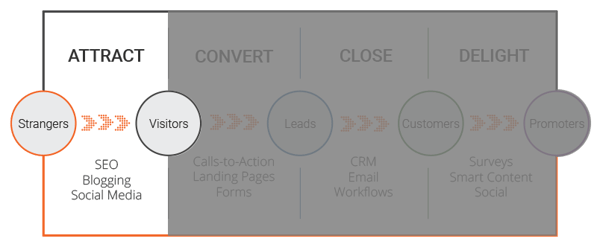ONLINE MARKETING PLAN
for Manufacturers
If you're like most small to medium sized manufacturers, you understand that the internet represents the biggest opportunity you have to generate new business in this day and age.
You've probably attended or sent people from your company to training sessions with titles like, "LinkedIn for Business", and "Improving Your Website 101", and returned to your daily grind with little to no progress on these tactics.
The key to successful online marketing for manufacturers is having a plan that utilizes all of the web tactics in an organized, and synchronized way. The online marketing plan for manufacturers that follows is based on a trusted and well tested methodology called, Inbound Marketing.
Dig in below to get started, or watch the overview video to the right.
Contents
Set S.M.A.R.T. Goals for Your Online Marketing Plan
One of the biggest causes for failure in marketing a manufacturing company is a lack of clear goals. Without concrete goals, you're throwing web tactics against the wall to see what sticks. That's not a strategy. You have to have clear targets to be successful.
That's where SMART goals come in. They ensure that your marketing goals are
- specific,
- measurable,
- attainable,
- relevant, and
- time-bound.
Marketing S.M.A.R.T. Goals Explained
Specific - This means we have to pick a particular metric and focus on it. We also need to identify who will be doing it, and what will the action plan be. How we're going to get there. So, maybe we're going to analyze visitors or leads or customers. So that's the specific metric that we want to focus on.
Measurable - to gauge progress towards the goal we need to quantify them. We need to understand if we're trying to achieve an X% increase or a solid number of something by a a time frame, which leads us to attainable.
Attainable - If we want to set let's say 20% increase in a metric, we have to make sure that that is rooted in reality. So the goal should be based on our own analytics not necessarily industry benchmarks. If you increased blog traffic by 3% last month, aim for 5 to 8 this month, not 20%. That's not attainable.
Relevant - Your goal should be relevant to your company's overall goals. Will more blog and website traffic yield more sales? Will Twitter followers yield more sales? Obviously those things are a yes so they are relevant.
Time-bound - This is probably one of the most important. Deadlines have to be set. You're going to achieve an X% increase in metric A, B, or C by this time frame. Deadlines apply pressure needed to make sure a team hits that goal.
Turning a Bad Goal into a SMART Goal
If this is your first go-round with Marketing SMART goals, it can be a bit challenging to get it right. Here's an example goal that IS NOT a SMART goal:
"We want to increase website traffic and leads."
On the surface, this makes sense as a goal. However, it lacks specificity, and many of the other elements of a SMART goal.
Let's start with the first item, specific. We're going to double our blog volume by blogging twice a week instead of once a week. Jim is going to contribute his regular blog post and Mary will now kick in and provide another blog post a week. So we're going to have two blog posts a week.
How do we make this measurable? By doing these two blog posts a week, we feel that we can increase our blog traffic by 6%.
This is attainable because we know that by kicking up our blogging last month, doing one blog post per week instead of one post every other week, we increased our blog traffic by 4%. We think by doubling the number of blog posts going out every, week we can increase our blog traffic by 6% this month.
Is it relevant to the overall goals of the company? By increasing our blog traffic we're going
to drive more visits to the website. We're probably going to generate more leads and sales opportunities. And, we're going to grow our brand awareness. This definitely lines up and is relevant
with company goals.
Now how do we make it time-bound? We say that we know we're basing our plan on data from last month. We're saying by the end of this month. If it's September, we're saying by the end of September. The last day of September, close a business, we're going to have seen a 6% increase in blog traffic.
We put it all together in one smart goal that says:
"By the end of September, we're going to increase our blog traffic by 6%, by increasing our blog posting frequency from one post a week to two posts a week."
For help with your SMART goals, check out this FREE SMART Goal Workbook: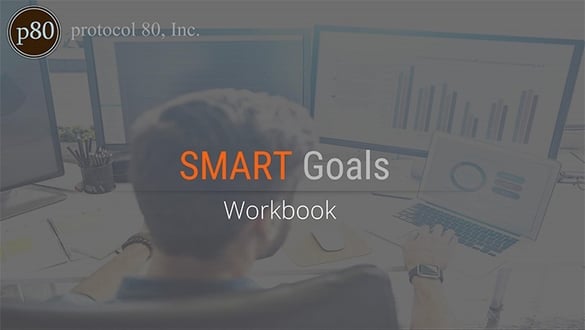
Web Metrics that Matter for Your Online Marketing Plan
To set good marketing SMART goals, you need to have a grasp on the metrics that matter. If you've ever researched web marketing metrics, you know there are countless things you can keep an eye on.
Here's a breakdown of where to start - baseline metrics:
- overall website traffic,
- leads or conversion rate,
- sales opportunities that have been influenced by our website, or
- closed sales that have been influenced through our website.
The last metric means whether they've bought through the website or they found us online and that's what started the conversation.
These are really great high level metrics. If you're just getting started with your online marketing plan, and you haven't really focused on these numbers very often, this would be a great place to start. You will quickly find that there are many other metrics that impact these baseline metrics.
More Granular Manufacturer Marketing Metrics
Let's start with website traffic. So when we look at website traffic, there's all sorts of elements that go into driving new website visitors. We'll have things like:
- visitors by source - where are they coming from? Email? Social media? Direct traffic? Search? Paid ads? What source is driving visitors to the website?
- How much time are they spending on the site?
- What's our bounce rate? Are they leaving as soon as they land here?
- How many blog views did we have?
- Inbound links to us which helps with our search engine optimization?
- How many keyword impressions are we showing for in Google?
- What's our social reach, meaning how many followers do we have across the different social media platforms?
- How much of our content is being shared in those social channels?
- How many blog subscribers do we have?
- What's our email open rate?
- Email click-through rate? The number of people that open your email and click through and land on your website, becoming some of your website traffic?
- What is our net new email subscriber ratio looking like?
These are all really important metrics for website traffic and what kind of go into all of the potential channels driving eyes to your website.
If we take a step further, we can look at our conversion rate:
- what are calls to action doing? What are the CTA conversion rates that we're seeing?
- What are the landing page conversion rates? So how our landing pages are turning visitors into leads?
- What are our leads by source? Are we getting more from organic search or are we getting more from email or social channels?
Those are some of the conversion related metrics. There're certainly more metrics that you can monitor in all of these categories, but this is a great start for to get going with your online marketing plan.
Then diving a bit deeper down the funnel, take a look at sales opportunities.
- How many of your leads turned into actual sales opportunities, where you're having a
conversation, and you know that they're qualified to buy. They may or may not buy, but you at least are having a good quality conversation with them. - How many of those leads are turning into those SQL's?
- How many of those sales opportunities are turning into customers?
- How many leads are turning into customers ?
These are all metrics that you can track and set goals for month-over-month to continually improve your numbers.
Building Your Buyer Persona(s)
Once you have some SMART goals in place using metrics that matter, you MUST make sure you're clear on who you're targeting with your online marketing. Personas make sure you're marketing tactics are executed with your best buyer as the focus, every time.
Buyer Personas help manufacturers like you understand your best buyer as the engineer, professional buyer, or executive that they are. We need to be able to relate to our best buyers as human beings, not just a demographic profile.
So, what's a good broad based definition of Buyer Personas?
Think of buyer personas as a fictional representation of your best buyer and what they thing throughout their buying process.
It's important to remember that your buyer persona is not a specific best buyer that you have. For example, let's say you've worked with Susan at XYZ Company for 20 years, supplying them the parts they need, and you just love working with them. It's easy. They appreciate what you do. They pay you fairly, and everything is wonderful.
Susan is representative of your buyer persona. She has characteristics or that company has characteristics of a buyer persona, but you don't want to just target Susan, because by just targeting her, you're excluding Steve, James, Anna, and Sue everywhere else, that may be an ideal buyer for you.
You want to take a clump of your best buyers, and get an idea of all of their characteristics. Why are they best buyers? How do they go about their buying process? It's going to vary a bit from buyer to buyer.
Your buyer persona will be solid if you can answer the all of the 'W' questions:
- Who,
- What,
- When,
- Where,
- Why,
- and then ultimately How, which isn't a 'W' but you get the point.
You might be thinking, "Donny, this persona thing sounds great, but where in the heck am I going to get all these insights?".
Primary Research, and Secondary Research
Primary Research includes interviews and surveys. We want to grab a range of 6-10 existing customers that fit this profile of being an ideal, perfect buyer, as well as companies that maybe you lost along the way. These are all great interview sources. You're going to need about 30 minutes of their time to ask them some very broad range questions. The biggest being, WHY?
For example, when you ask them a question about what motivated their company to start their research process before you found us, and they provide you an answer, you say 'Interesting, why is that?'.
'Why' should be your go-to question, over and over again, because the 'Why' is where the insights are for where you need to be online, what content you need to produce, and how your marketing can reach them.
The second primary research, surveys, is great for those individuals, that are not comfortable being interviewed, but are willing to share some insights. You're not going to get as many as you will with an interview because you can't continuously probe for deeper answers, but you can set your survey up with 'Why' as well. Why did you answer that way?
That's valuable information straight from the horse's mouth, primary research. You'll want to log all of this. If you can record your calls, obviously with their approval, or use video, you can see their mannerisms, and how they handle things. That's a wealth of information for your sales and marketing team.
Then, you have secondary research. This is data mining. You have a CRM. You have past customer information.
Your sales people are a good resource. Your customer account reps are a great resource. Pull all that data together and culminate it into one pile of research that you're then going to work on to establish your buyer persona.
At this point, once you've gone through an initial stage of research, it's time to put your persona together, and start to document that actual profile.
Here's a link to an awesome resource. It's a completely FREE resource that even includes a worksheet for taking this information that you've gathered, and putting it into an actual buyer persona.
It also dives deeper into some of the items that I've already covered here in terms of research, and questions you should ask during your persona interviews, and what the whole process looks like. It's called the Ultimate Guide to Buyer Personas, for Beginners.
Applying the Buyer's Journey
Understanding your buyer persona is so important. Understanding how they start their buying process, or buyer's journey, is every bit as important!
Let's break down the Buyer's Journey. This spans from the moment that your best buyer decides they they have some symptoms or things that are alluding to a problem, that they're going to research, and find some options or consider ways that they can solve this problem, all the way down to when they make a buying decision. They pit you against your competitors, and ultimately decide to with you or your competitor, in the decision stage.
So, the buyer's journey is broken down into Awareness, Consideration, and Decision. We're going to walk through each stage, next.
Your Persona's Awareness Stage

In the awareness stage, your persona is identifying symptoms and trying to pinpoint what their real problem is. They're starting to dig in and do some research on why they're seeing a symptom and trying to determine what problem is causing the symptom, giving it a definition, and then getting ready to move on to find options for solving it.
They may also be faced with a new opportunity that they need to do some research on. Either way, they need to educate themselves.
You need to have content on your website, your blog, social media, that speaks to these symptoms or challenges, so that when your ideal buyer hops on Google to start searching, they find your website.
Remember, it's about being at the right place, at the right time, with the right message. That's what we can do in the Awareness stage if we understand the symptoms and/or opportunities that drive our ideal buyer to look for the solution we provide.
This stage can take 15 minutes for some prospects, and it can take months for others.
Example of the Awareness Stage for Manufacturers
 Let's take a look at an example buyer that's in their awareness stage. Let's say that you're an engineer, and you've been tasked with designing a component for your company. This component is enclosed in a metal box, and your Q&A tests keep coming back and saying that it's corroding after a very short amount of time when it's exposed to moisture.
Let's take a look at an example buyer that's in their awareness stage. Let's say that you're an engineer, and you've been tasked with designing a component for your company. This component is enclosed in a metal box, and your Q&A tests keep coming back and saying that it's corroding after a very short amount of time when it's exposed to moisture.
You obviously have some symptoms, right? The corrosion is a symptom of a problem that you need to solve with your design.
Since the enclosure for this component is made out of carbon steel, you hop on Google and you start researching. 'How fast should carbon steel corrode?' Because, this component is not going to be exposed to the elements very often, but it may get some moisture exposure every once in a while.
In your research, you find that carbon steel is a very cost effective metal to use for the enclosure for this component, but it's not very corrosion resistant. So, you've found your problem. You have a non corrosion resistant material around the outside of your component and it's not withstanding the moisture that it's being exposed to.
So, we've got an idea of what our problem is. Now we need to try and determine how we're going to solve it.
That quickly, the awareness stage is complete. They've determined what their problem is and they engaged with somebody's content online. There's a big hint for you about being in the right place, at the right time, with the right message.
That resource, if you are a metal manufacturer, could/should have been your blog. As an online marketer, it's your responsibility to be there when they're researching around their problems.
If an engineer was doing research on carbon steel corrosion, you obviously would want to have some content on your website or resources available on your blog around carbon steel corrosion, and options for solving the corrosion issue. This leads us to our next stage of the buyer's journey, the consideration stage.
Your Persona's Consideration Stage

In the consideration stage, your persona is starting to look for options to solve their problem. Ultimately, they're going to come down to the THE option that they want to pursue in the consideration stage to solve their problem.
As an online marketer, you need to pick up where the awareness stage lets off, and recommend content to this ideal buyer that lays out options for solving their problem, including ones that you provide.
Consideration Stage Example for Manufacturers
 If we pick up with our example from before, our engineer may hop on Google and search for 'carbon steel corrosion inhibitor', or 'finishes that prevent corrosion', or 'corrosion resistant metals', or 'best metals for corrosion resistance'. They're going to continue their research process until they find some options that are going to help them solve this problem. Ideally, narrowing it down, using the constraints I mentioned earlier, to pick one option.
If we pick up with our example from before, our engineer may hop on Google and search for 'carbon steel corrosion inhibitor', or 'finishes that prevent corrosion', or 'corrosion resistant metals', or 'best metals for corrosion resistance'. They're going to continue their research process until they find some options that are going to help them solve this problem. Ideally, narrowing it down, using the constraints I mentioned earlier, to pick one option.
The engineer makes the decision that they have a budget they need to stick to. They know that paint will work, so they'll have their enclosure painted, as opposed to switching to something like galvanized or stainless steel that will destroy the budget.
They've now decided that they're going to have this enclosure painted, to help it resist corrosion, because they know it's not going to be exposed to moisture very often or for very long periods of time. This should just do the trick.
Now, they're at the end of the consideration stage.
Your Persona's Decision Stage

Now, your persona needs to make a decision on who they're going to work with. They think back to all this research they've done, and there have been a couple of websites that they've seen repeatedly that have provided most of the answers. They even received some follow up emails from one of the websites after they downloaded a guide to finishing metals.
So, they go back and check out these 2 websites out and see if they fit some of my constraints, like geography. They want to save on freight, if they're going to have to ship these things back and forth to be painted. They also want to make sure that they've got some testimonials, or at least some other people that say, yep, these guys know what they're doing, and it turns out both of these websites are great options. They're geographically close enough, they have testimonials that say the lead times are short, the quality has been good.
So, they're going to reach out to both of them and submit an RFQ. In this decision stage, the best buyers are pitting the vendors, or the supplies, or the solution providers, against each other to determine which is going to be the best value, and the best fit for their company.
Finally, whichever one's the best value, the buyer goes with, and they pull the trigger and make a buying decision.
They've reached the end of their decision stage.
They've made a purchase. All along the way, an online marketer should be there providing them content and nurturing them through the buying process. Ideally, helping them move from awareness to consideration to decision, and being in front of them with your brand over and over and over again. Being genuinely helpful.
Combining Your Buyer Persona and Buyer Journey
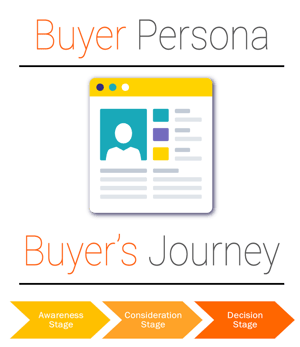
Now that you have a better understanding of the buyer's journey, you need to take the buyer persona that we created in the previous step and we need to map out the buyer's journey for that persona. We're going to look at the awareness stage, the consideration stage, and the decision stage, and we're going to determine what questions our ideal buyer has in each stage?
Then, we need to have content that answers those questions. By doing so, we can be there at the right place, at the right time, with the right message.
If you're a larger manufacturer with many, many capabilities, you might have many, many buyer personas, or buyer personas with different journey types, and you'll want to map that out for each of your capabilities.
Look at the capability. What problem does it solve? Work backwards from there. What are some of the symptoms that are going to be expressed that lead them to need that capability? Map that out, and come up with some rough draft titles for content that would be helpful to your buyer persona.
Attract More Visitors to Your Manufacturing Website
The Attract phase of the Inbound Marketing methodology is all about driving more quality visitors to your website.
For this to work you have to have a strong understanding of who the right people are (buyer persona), and the W's' (who, what, when, where, why, and how) of their research and buying process (buyer’s journey).
Your online marketing plan is going to focus on - Being in the right place, at the right time, with the right message.
The foundation for the attract stage is educational content. Some content types to attract visitors includes:
- Manufacturing Pillar pages
- Blog posts
- Your website pages
- Videos
- And social media posts
The Attract stage uses these types of content together in one strategy, to drive more website visitors.
Manufacturing Pillar Pages
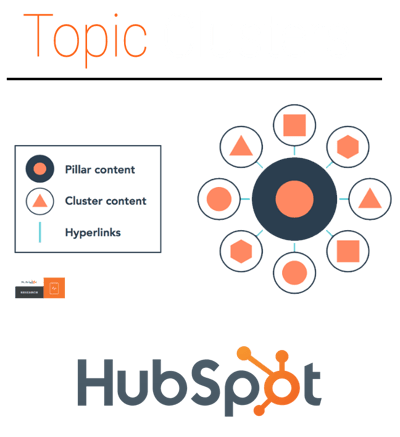 Let's starts with manufacturing Pillar Pages. If you’re new to pillar pages, think of them as a main page on your website. Meaning it’s available from your website’s top navigation bar. It’s a broad, core topic that you are, or can be an authority on.
Let's starts with manufacturing Pillar Pages. If you’re new to pillar pages, think of them as a main page on your website. Meaning it’s available from your website’s top navigation bar. It’s a broad, core topic that you are, or can be an authority on.
For example, if you are a plastics manufacturer, you might have a broad pillar page on ‘plastic injection molding’.
This would be a very long page. Think thousands of words. It would be content aimed at answering all of the top questions about the topic, from your buyer persona’s perspective.
Again, refer above in this series for examples of the types of content that will resonate with your buyer persona at each stage of their buyer’s journey.
A manufacturing pillar page is meant to be pure education. You want it to be a resource for people researching ‘plastic injection molding’. You might want to touch on things like:
- How plastic injection molding came to be - who invented the process and when?
- Why it is used?
- What the process looks like?
- What types of parts are best suited for plastic injection molding?
- Strengths and weaknesses of plastic injection molding.
- Cost of plastic injection molding.
- Advances in technology with plastic injection molding.
There are probably other top questions that could be answered, but you get the idea.
Notice, I didn’t include things like:
- How long you’ve been doing injection molding.
- All of your certifications in injection molding.
- OR, examples of your work in injection molding.
We want to think more strategically with our pillar content. If someone has a broad interest in learning about injection molding, they aren’t looking for a provider yet. They are just learning.
We’ll have opportunities in later stages to filter out the actual prospects. The key is to get more visitors to your website, which will obviously include potential buyers.
You want your manufacturing pillar content to become THE resource for anyone trying to learn about plastic injection molding. This will invite inbound links from other sites that need a resource for their visitors on plastic injection molding. These links are HUGE factor in increasing your website’s authority and SEO.
Cluster Content Through Blogging
Now we need to look at how we create a cluster of content that integrates with our pillar content.
Cluster Content can be thought of as subtopics for your pillar content. They are typically blog posts that use longer-tail keywords that relate back to the pillar topic.
Using our ‘plastic injection molding’ example, some subtopics might include:
- 5 Ways to Design for Mold Efficiency, Performance, and Longevity
- Getting Your Injection Molding Tolerances and Metrology Right
- 10 Best Materials for Plastic Injection Molding
These are shorter pieces of content that will live on your blog, and link to your pillar content. Every time you write a subtopic for the pillar content, you’ll update the pillar content to include a link to your subtopic. In other words, your subtopic will link to the pillar content, and your pillar content will link to the subtopic.
These links, bind the content cluster strategy together, making a direct connection that Google can easily see.
Do you have a website page that relates heavily to the pillar content or a subtopic blog post? Link to them! And vice versa.
Pillar Content and Subtopic Content Types
I want to take a moment here to note that your pillar content and subtopics should be primarily text, but can also include things like video, tables of data, and graphics. Whatever would be most helpful to the visitor. You can also plan to go back to a pillar page or blog post and add in a video or other more time intensive media after it’s launched.
Getting Eyes on Your Manufacturing Content
Just publishing a manufacturing pillar page, or subtopic content doesn’t guarantee that you’ll get a flood of new traffic. This is especially true if you have a very low trafficked website. That’s how social media and pay-per-click come into your Attract strategy.
Social Media
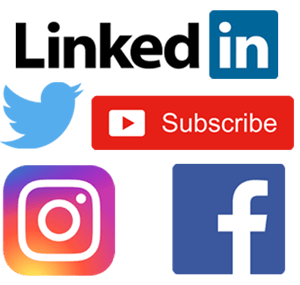 Let’s start with social media. LinkedIn, Twitter, Facebook, Instagram, etc… When I refer to social media, I’m talking about the channels your buyer persona spends time on. In your persona interviews (Part 3 of this series), you should have uncovered which social networks they use.
Let’s start with social media. LinkedIn, Twitter, Facebook, Instagram, etc… When I refer to social media, I’m talking about the channels your buyer persona spends time on. In your persona interviews (Part 3 of this series), you should have uncovered which social networks they use.
Social channels offer us an excellent platform to distribute our content, and other people’s content that would be helpful to our buyer personas.
If you have a very small following in your social channels, I recommend deploying the 10:4:1 rule for a period of time, until you have more followers.
This rules says that out of 15 social posts:
- 10 should be shared content from other people (tagging them and giving them credit)
- 4 should be your own sub topics/blog posts
- 1 should be to your pillar page, or a landing page with an ebook to download
At the same time, you should be following as many relevant people in your social channels as possible, from your company’s social accounts.
You’ll want to research which hashtags are used heavily in your industry and be sure to use them when possible to expand your footprint to non-followers that are searching by hashtags.
As your social reach grows (again, refer to Part 2 for Metrics and Smart Goals), you can test changing the ratio from 10-4-1 to something like 8-5-2, or 7-6-2. You should never do away entirely with sharing other people’s content if it will help you buyer persona.
Remember, people that find your content through social can share your content, expanding your reach, and maybe driving more inbound links. A huge factor in SEO.
Social Media Tips:
There’re a few things I’d like to note on using social media:
- A blatant sales pitch will be treated like a cold call at dinner time… people won’t like it. Save any attempts at this until you have 1,000s of followers. Then measure the unfollow rate carefully to see if it’s worth it.
- There are tools, like HubSpot, that make monitoring social media channels for engagement (likes, follows, shares) very easy, so you don’t have to jump from channel to channel
- Your industry and the specific channel you’re using should be tested for acceptable posting frequency and best times of day. There are broad suggestions online if you search for them, but your mileage may vary.
- Be proactive in continuing to follow new, relevant accounts, and sharing people’s posts. There’s a goodwill effect with social media that can pay dividends over time.
Please understand that your social reach will take time to grow - don't give up!
Pay-Per-Click (PPC) Advertising - When You Need Traffic NOW
To that point, getting eyes on your manufacturing pillar content and subtopics may require some investment in pay-per-click advertising, depending on your level of patience, and the amount of traffic you currently get to your website.
I won’t get into the nuts and bolts of PPC here, but I will leave you with a few pointers:
- Google is a great place to start - Adwords can get your pillar content or subtopics at the top of search results for a very low cost per click, especially if there’s little paid competition an/or the keyword is longer-tailed.
- Set a daily budget so your spend is predictable. If you only want to spend $500-1,000/month, that’s achievable.
- Refine your targeting as much as possible. If you are only competitive on the east coast, only show your ads to folks on the east coast.
- Social channels are another great option for paid traffic, with even more targeting tools.
- Promote content that performs well organically too - this seems counterproductive, but if it resonates with the organic audience, you should get it in front of a broader paid audience as well.
3-Month Plan for the Attract Stage of Your Online Marketing Plan
I can hear the groans now! You already have a lot on your plate as a marketer, sales professional, or executive, so how are you possibly going to do all of this?
Here’s how I’d break down a quarter if I were you:
Month 1:
- Get your pillar content done and published on your website
- Setup and brand all of the relevant social channels for your persona
- Follow 100 accounts in each channel, and start sharing other people’s content exclusively with a few thoughts on what you shared
- Share your pillar page twice
Month 2:
- Write a subtopic blog post that relates to your pillar content, every week
- Integrate your blog content in your 10:4:1 schedule
- Follow another 100 accounts in each channel
Month 3:
- Write a subtopic blog post that relates to your pillar content, every week
- Integrate your blog content (old and new) into the 10:4:1 schedule, ramping up the volume of posts each week where appropriate
- Plan next quarter’s sub topics that relate to the pillar content
- Review your metrics - see Part 2
Setting Up the Technical Pieces
If you’re hung up on how to setup a blog and get that going, check out my video on the ‘10 Steps to start a manufacturing blog’.
Convert Manufacturing Website Visitors into Leads
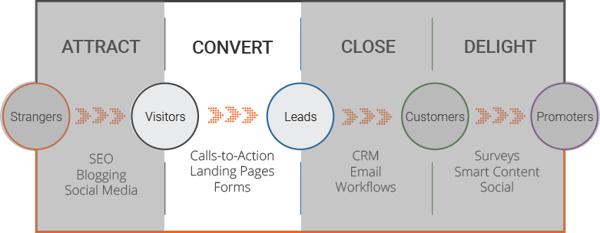
The Attract stage helps us get more website traffic, but unless we can convert an increasing number of those website visitors into leads and customers, that new website traffic is pointless.
If you’re like most manufacturers, you’ve undoubtedly relied on an RFQ and Contact Us form on your website to generate leads.
Unfortunately, nothing says used car salesmen more than sliding a contact us or RFQ in front of a website visitor in the awareness stage of their buyer’s journey.
Today's Manufacturing Buyer Avoids the RFQ & Contact Us as Long as Possible
To turn today’s manufacturing buyer into a website lead, you need to add value. You need to continue to help them. Much like we used educational content on our blog, to attract our buyer persona at each stage of their buyer’s journey.
To convert them into leads, we need to up the ante a bit on our educational content or add value with the content we’re already offering.
How to Leverage Content for Manufacturing Lead Generation
Our first lead generation opportunity, should come from our newly created pillar content (see the steps outlined in the previous section). Recall that a pillar page is a VERY long, thorough piece of content that covers all of the most common questions around a broad topic. The example we used in the previous section was ‘plastic injection molding’.
Because this content is very long, many readers won’t have the time right now to read the whole page, BUT they’ll want to be able to refer to the information easily, later. They could also be viewing the page on their phone and want to wait to read the whole thing from a larger screen or kindle.
To add value for the reader, we can make a PDF version of the pillar content we’ve already produced, and let them download it for:
- offline reading,
- printing,
- Kindle loading, and
- easy sharing.
To turn this visitor into a lead, we can request their email address, and other optional information, to send them the PDF. We’ve now generated a website lead, and we didn’t have to ‘sell’ them. All we did was add value.
Premium Content Offers for Manufacturers
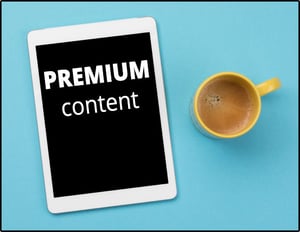 Premium content offers are another great way to generate leads using content. Premium content includes things like:
Premium content offers are another great way to generate leads using content. Premium content includes things like:
- Ebooks,
- Guides,
- Case studies,
- Webinars, and
- White papers.
Leveraging the example from our previous step, if you’re a plastics manufacturer, you probably have the knowledge to produce a simple ebook called, ‘The Guide to Planning an Injection Molded Part’.
This guide would be highly relevant to your plastic injection molding pillar content and topic cluster, so it would be another great lead generation offer.
The key here is to take your blog content, and pillar content, and think of what your buyer persona’s next steps might be, within the context of their buyer’s journey. If it’s awareness stage content, you don’t want your premium content to be decision stage. It should be more awareness stage content, or consideration stage.
For a refresher on the buyer’s journey stages and examples of how to use it, check out video 4 of this series.
The Convert Concept
Hopefully you’re starting to get a clear picture of how we’re continuing to use content within the inbound marketing methodology to attract and convert visitors into leads. Helping them through their buyer’s journey.
If you conceptually understand how a visitor Googles a topic, lands on your site, and decides they want premium content, or to email the pillar page PDF to themselves, you’re doing great!
Technical Components for Online Manufacturing Lead Generation
You may be wondering how all of this ‘technically’ comes together though…
A short answer is the HubSpot Marketing suite, which is what we use here at p80, and nearly all of our clients use. If you aren’t ready for HubSpot, you can use WordPress with a suite of plugins called Inbound Now, Gravity Forms, and MailChimp, it’s just not nearly as intuitive, comprehensive, or easy to report on.
- Lead Flows,
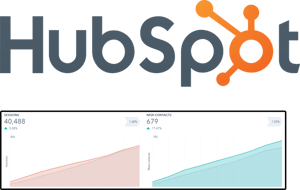
- Calls to Action (CTAs),
- Landing Pages,
- Forms,
- Your Digital Offer, and
- Thank You Pages
Let’s start with Lead Flows…
Lead Flows
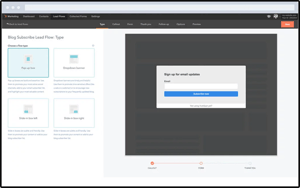 Have you ever been to a site where the content you’re viewing gets kind of grayed out and a window shows up over top offering you something? Or maybe you’re reading a page and a small offer slides in from the bottom corner? Those are called Lead Flows.
Have you ever been to a site where the content you’re viewing gets kind of grayed out and a window shows up over top offering you something? Or maybe you’re reading a page and a small offer slides in from the bottom corner? Those are called Lead Flows.
You might be thinking, but those are so annoying! And in some cases you’re right. They’re especially annoying when they don’t have any relevance to the page you’re reading. BUT, when they are extremely related to what you’re reading, or they allow you to advance your research, they are VERY helpful to the reader and your lead generation efforts!
Again, we recommend HubSpot. The free version includes Lead Flows, and is extremely intuitive. You can select the pages you want your lead flows on and specify parameters that trigger the lead flow to show, such as scroll position on the page, or time viewing the page.
The lead flow allows the visitor to complete a form right in the popup or slide in window to get an offer, which generates a lead.
Lead flows are sort of an all-in-one tool for getting the visitor’s information, using content.
The other pieces I mentioned, all work in tandem.
Calls to Action - CTAs
When a visitor reads a blog post or pillar page, they have to be alerted to the fact that there’s a premium offer or added value for them. That’s where Calls to Action come in. We’ll use a graphic or button call-to-action (CTA) to direct them to download the premium offer. Think of a CTA as mini-billboard meant to grab the reader’s attention and direct them to do something.
Here’re a couple example CTAs you could place at various points throughout a pillar page or at the bottom of a blog:
A simple button with a directive to download the PDF
A more graphical CTA callout
Technically speaking, these are just buttons or images that link to a landing page with a form, where the visitor can enter their contact details in exchange for the premium offer.
Landing Pages
Speaking of Landing Pages and Forms… A landing page is a page on your website that is meant to promote a premium offer and further ‘sell’ what the CTA was pitching. There’re tons of resources online for landing page best practices, so I won’t get too far into them now, but here are a few things to note:
- should have no navigation bar,
- should be brief and promote the offer, and
- must include a form where the visitor can enter their details.
Forms
 A little about the form. The form on your Landing Page should use the buyer’s journey context, much like your content. If the premium offer the visitor is downloading is an awareness stage offer, keep the form very minimal with things like company email address, first name, last name, and optionally their company.
A little about the form. The form on your Landing Page should use the buyer’s journey context, much like your content. If the premium offer the visitor is downloading is an awareness stage offer, keep the form very minimal with things like company email address, first name, last name, and optionally their company.
If the premium offer is more decision stage, ask a few more probing questions that will help you in the sales process. But keep in mind that the more you ask, the fewer people will fill it out. Techniques like progressive profiling can be helpful here, where you progressively ask for more details from them as they download more content from you.
When the visitor clicks the submit button in the form on your landing page, a few things have to happen…
CRM, Notifications, and Emails
The new lead’s contact details should go into your CRM - Again’ HubSpot’s FREE CRM is the foundation of all of their tools, so if you’re using HubSpot, the contact details will go directly into the CRM
A notification should be sent to the appropriate people on your team, maybe sales, to research this lead and see if we should follow up.
A Thank You email with a link to the premium offer should be automatically sent to the lead, and ideally they should be entered into a lead nurturing workflow (more on that in the next video).
Thank You Page
The lead should then be redirected to a Thank You page with a link to their premium offer, and a ‘Next Step’ offer up-sell.
I’ll link a video in the description below that shows how a lead is generated with the Inbound Marketing methodology. It walks through a visitor finding a site through Google, all the way through turning into a lead.
Recap Technology
Again...HubSpot’s Marketing tool does all of this setup with a step-by-step system. It does everything it can to simplify the process, and because it’s all in one tool, the reporting is phenomenal.
You can do this without HubSpot, but you’ll need to know how to put the pieces together that I mentioned earlier, to get it to work.
3-Month Plan for the Convert Stage of Your Online Marketing Plan
So how does the Convert stage fit into the first 3 months of your Online Marketing Plan?
In Month 1:
- After you’ve completed the Pillar page:
- Make a branded PDF version of the page. You can use Microsoft Word or Google Docs for this.
- Create a landing page with a form that highlights the benefits to prospect of downloading the PDF.
- Create a thank you page that allows the lead to download the PDF.
- Create a CTA button or image that promotes the PDF version of the Pillar content.
- Add the CTA at the top, middle, and bottom of the pillar page.
- Create a lead flow for the pillar page PDF and set it to display on the appropriate pages of your website and/or blog.
In Months 2 & 3:
- For each blog post you write this month:
- Add a CTA at the bottom for the Pillar Page or Pillar Page PDF landing page
- Test a lead flow with varying triggers on your new, relevant blog posts.
Close Manufacturing Website Leads into Customers
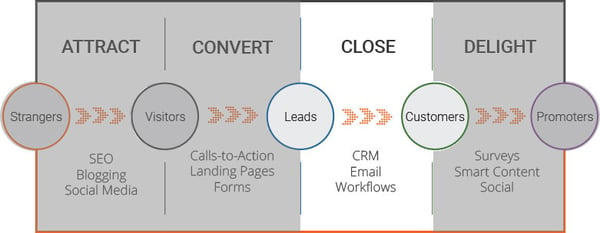
By now you should know that today’s manufacturing buyer does a ton of research before they’re ready to buy. Remember the Buyer’s Journey!? If a visitor is in the awareness or consideration stage, they’re probably just looking for education, not a sales conversation.
How then do we handle the variety of manufacturing leads we’ll see through our website?
It starts by having a clear understanding of your conversion opportunities’ alignment with your personas’ buyer’s journey.
If a website visitor lands on your manufacturing website and reads content targeted to the awareness stage, then downloads an awareness stage eBook, you should have a pretty clear understanding of where they are in their buyer’s journey… Their Awareness Stage.
If they land on an awareness stage blog post, and convert into a lead by downloading a Consideration stage offer, they’re either in their awareness stage or consideration stage. You’ll need to approach them a little differently.
You get the idea, right? Closing a lead into a customer requires understanding their context and providing support through lead nurturing to move them through their buyer journey.
What the Heck is Lead Nurturing?
I’ve referenced lead nurturing a few times now so I want to provide some insight into what I’m talking about.
Lead Nurturing is the process of supporting an early stage manufacturing lead, (one that’s not buying right now or in their decision stage), with automated emails and supportive touch points. Lead nurturing goes by several names, including marketing automation, drip campaigns, auto-responders, etc...
You might recall from the last section that when the website visitor downloaded an Awareness Stage eBook, we needed to automate an email to the lead, thanking them for downloading the content and providing a link to the resource. This is often the first step in the nurturing stage.
BUT, our communication with them shouldn’t stop there. Our goal is to move them through their buyer’s journey and turn them into Closed deals.
Lead Nurturing Emails for Manufacturers - Marketing Automation
A few days later, we should send them another automated email, asking if they had any questions about the resource they downloaded. Something like:
Hey [Lead Name],
A couple days ago, you downloaded an ebook on [Topic]. I just wanted to touch base real quick and see if you had a chance to read it? If so, did it answer your questions? If not, I’d be happy to help.
Also, many folks that download this eBook, also have questions around [Topic #2 - Consideration Offer]. Here’s a link to another eBook we created with a ton of helpful information on that topic.
Regards,
[Your Name]
A few points about this email before we move on:
- This email recognizes the lead’s buyer’s journey stage - Awareness and treats them as such
- I didn’t once try to sell them in this email
- I tried to be low pressure and helpful
Now we’ve sent 2 automated emails. Our hope is that the lead will either respond to this email and start a dialog, or take advantage of the 2nd offer we’ve provided a link to.
Either way, we want to further qualify this lead and move them along their buyer’s journey. They may jump right to their decision stage and email you to start a sales conversation, but they also might need more support to get there.
Using marketing automation, we can wait a couple more days and leverage our CRM to determine if they’ve taken advantage of the second, consideration stage, premium offer we sent.
If they have, we need to automate an email to them, similar to the last email we sent. We need to ask if they need any questions answered, and suggest either another consideration stage resource, or a decision stage resource.
If they haven’t downloaded the consideration stage offer, we should automate another email to them asking if they have any questions, and suggesting a more awareness stage offer. Something like:
Hey [Lead Name],
I’m just checking back in with you to see if you got my last email? I noticed that you didn’t respond and haven’t downloaded the [Topic #2 Offer].
I just want to make sure you’re getting all of the information you need! I may have misinterpreted what you’re researching. Here’s a guide to [Topic #3] that might be helpful if your situation is more [fill in the situation].
I hope this helps!
Thanks,
[Your Name]
Again, I’m trying to be helpful here. The goal is further qualification of this lead and moving them down the funnel towards their decision stage.
I recommend sending 4-5 emails, with the last email being a ‘break up’ up email, similar to the following:
Hi [Lead Name],
I hope all is well! It’s been a couple weeks since you’ve downloaded [Titles]. I hope it was helpful and that you’ve been able to answer the questions you had.
Since I haven’t heard back I’ll assume you’re all set. I won’t follow up again unless I hear back from you.
Thanks,
[Your Name]
This approach will sometimes elicit a response. They may have been busy, or putting this off, and a break up email will get them to at least keep the dialog open.
Nurturing Consideration and Decision Stage Manufacturing Leads
The example we’ve been using here is for a lead presumed to be in their Awareness stage. The process is similar in the Consideration stage. In the consideration stage you might want to share content that helps the lead weigh the options they are likely considering.
In the decision stage, you can be a bit more forward. If the lead downloads a case study on how you saved a client Millions of dollars, you can automate decision stage emails to them that dig a bit more into the problems they are having and how you could help them solve them.
I also recommend connecting on LinkedIn with them and maybe some of their coworkers, if the lead is in their decision stage.
Manufacturing Lead Nurturing Gives Salespeople More Context
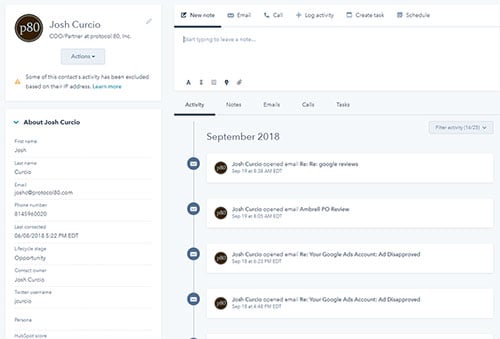 You can see that lead nurturing is a way for us to try to continue the conversation with a lead, while further qualifying them. When you send them a new resource that may help them, you can use progressive profiling to ask a different set of questions on the landing page form. Gaining further insight into their current problem.
You can see that lead nurturing is a way for us to try to continue the conversation with a lead, while further qualifying them. When you send them a new resource that may help them, you can use progressive profiling to ask a different set of questions on the landing page form. Gaining further insight into their current problem.
When all of these emails, and form submissions are tracked in your CRM, your sales people will have tremendous context around each lead, and how they can help them.
Lead Nurturing Technology
I’m sure you’re wondering how to make this happen from a technology standpoint. As in other steps in the process for your online marketing plan, I highly recommend HubSpot. Their Workflow tool is the most intuitive that I’ve seen for setting up marketing automation. It includes conditional branching like I mentioned above, so you can send emails based on steps a lead has taken. You can also automate tasks to salespeople for connecting on LinkedIn or picking up the phone to reach out.
If HubSpot isn’t an option for you, you can integrate MailChimp with a form submission on your website. They allow for follow up email automation and drip campaigns. It’s clunkier than HubSpot, but it can work.
Plan for the Close - Lead Nurturing Stage of Your Online Marketing Plan
As far as timing goes for integrating this step into your online marketing plan. I’d recommend having a workflow with 4-5 email follow ups setup by the middle of Month 2 of your Online Marketing Plan. You can start with an automated thank you and delivery of the Pillar Page PDF we discussed in previous videos, but you should quickly add in the additional follow ups in Month 2.
Generate Referrals Through Customer Delight
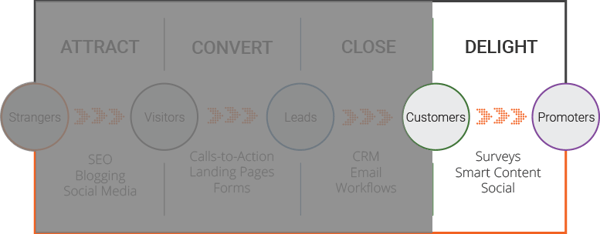
According to the White House Office of Consumer Affairs, it costs businesses 6-7 times more to attract new customers than to retain existing ones.
Unfortunately, most manufacturing sales and marketing efforts are focused on NET NEW business, rather than creating an experience that keeps customers on board, and buying more.
The pioneer of Inbound Marketing, HubSpot, recommends, 4 key components to delivering delight:
- Solve Current and Potential Customers’ Problems
- Be Helpful
- Help them Achieve Goals - this spans marketing, sales, and service
- Be enthusiastic - In every interaction with prospects and customers
Are these 4 things that you do well, across the board? Meaning in marketing, sales, and service? Like any business, you probably know of some areas that you should tune up a bit.
The good news is, by following this video series and building Your Online Marketing Plan, using Inbound Marketing as the foundation, you’re already working on the delight stage.
Think back on the approach we’ve taken in previous stages above to thoroughly understand:
- our buyers’ problems,
- how we can be a source of education and support for them, and
- how we can build as much context around their situation as possible to better serve them in the sales process.
Our plan makes sure we’re building an experience of delight from their first touch point with our manufacturing company.
But, let’s look at a few more details for the 4 key components, shall we?
Solve Current and Potential Customers’ Problems
You are in business to do this, right? You offer a solution to a problem. Your online marketing plan offers guidance to your prospects to help them find the right solution for their problem.
Taking this a step further though, do you always direct your customers and prospects to the solution that’s truly best for them, versus what’s best for you? If not, are you earning referrals and turning them into promoters? Probably not.
Be Helpful
Your online marketing plan will certainly deliver prospects helpful information. How are you adding value for your existing customers? Are you continuing to provide them with information that will help them succeed? Even outside of your business relationship?
You may manufacture a component for them, but wouldn’t they also benefit from some overall manufacturing best practices? You could easily share content with them that is helpful, further delivering delight beyond when they sign a PO for you.
Help Them Achieve Their Goals
What is your customer’s end goal on having you manufacture something for them? If you said, “To get a part they need, at the right quality, in the right lead time, at the right price.”, you have a small piece of their end goal. You are probably making a piece of something much larger. What’s the goal with their project? It’s not just about your dealings with them.
Are there aspects of their project that you could help them be successful with, EVEN IF you don’t do the work on those aspects? Could you be offering valuable support to your customers? That’s the type of effort that delights a customer.
Be Enthusiastic
I’m not talking about O.D.-ing on Happy Pills and bringing pom-poms to work every day. I’m talking about making sure your company’s voice is enthusiastic, fun, and welcoming, in every prospect or client interaction.
This might mean faking it to hide a case of the ‘Monday Blues’. That’s OK. The idea here is that enthusiasm is contagious and leaves your prospects and customers with a positive feeling.
Delight is a Different Type of Strategy
Unlike the rest of this stages in this plan, Delight covers a lot of intangible things. Things that you need to build into a regular training regiment with your marketing, sales, and service people. The whole goal here is to have a dedicated effort to turn more of your customers into referrers, promoters, and bigger customers.
As the stat I mentioned above shows, this investment of time and effort can mean spending much less on growing your top and bottom lines in the future.
Plan for the Delight Stage of Your Online Marketing Plan
So, How do you get started with this stage of the Inbound Marketing Methodology in your Online Marketing Plan?
Month 1 - Get this Online Marketing Plan in action. You’ll be helping prospects and customers to Solve Problems, and certainly being helpful to them.
Month 2 - In the middle of Month 2, I’d recommend bringing in the heads of Sales, Marketing, and Service, and having a constructive, open dialog about what you can do pre-sale, post-sale, and ongoing to deliver an exceptional experience. You may want to start with furthering your educational content experience. Should you start a knowledge base for existing customers? Should you proactively connect with your clients to see how else you can help them? Make a list and decide what you can realistically start on now.
Month 3 - Communicate your standards for enthusiasm in your all of your interactions. Explain the why, how your team will be held accountable.
Now Document Your Online Marketing Plan for Manufacturers
Your next step has to be documenting your manufacturing company’s plan and getting ready to kick it into action! I’d be happy to review your plan, free of charge, if you’d like. Just email your plan to donnyk@protocol80.com.
What's Your Plan?
Would you like a helping in hand in setting the right course with your online marketing plan?
Use the form to the right to have a conversation with one of our experts!




